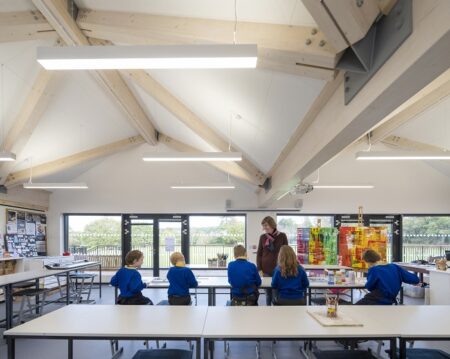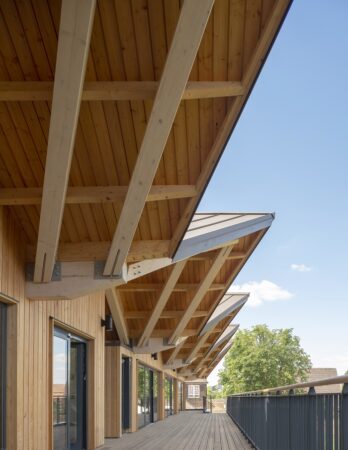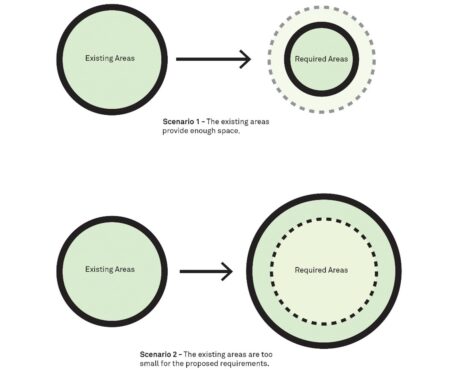Three strategies for your campus in challenging economic times
Jerry Tate, founder and director of Tate + Co Architects, masterplanners and interior designers, looks at the different strategies education estates providers can use to improve their campuses in a difficult financial climate

Jerry Tate

On top of this I am also a governor at an independent school.
So, I know that these are challenging economic times for many education institutions.
This article sets out three strategies that make sense when you have financial constraints and want to maximise the positive impact of your campus and create the very-best learning environments.

Strategy 1 – Make sure you have the right-sized campus
At Tate+Co a key first step we always take when starting a project is to check if an institution’s campus is the right size.
You can check this by following this approach:
Step One – Measure the area of your existing estate. This can be achieved through desktop exercises, physical surveys, or a mixture of both, and will provide valuable insights into how your estate is used and the mixture of different spaces you currently have.
Step Two – Benchmark your estate. Armed with a list of areas and overall size, you can now benchmark your estate against other similar estates. We often complete a desktop study of institution’s competitors to see if they have comparable facilities (you can do a lot on Google Earth). And there are spatial benchmarks to check if you have too much, or too little, space. Below are some guidelines based on a combination of our experience, and research by the Association of University Directors of Estates (AUDE); the Independent Schools Bursars Association (ISBA); and the Department for Education spatial guidelines (BB103):
| Types of institutions | Estimated GIA per FTE (m²) | BB103 guidance |
| University – Teaching focused, urban | 5–7 m² per FTE student | |
| University – General campus-based | 7–9 m² per FTE student | |
| University – Research-intensive/STEM-heavy | 9–12+ m² per FTE student | |
| School – Primary, day only (KS1 & KS2) | 7 – 9 m² per pupil | 5 – 7 m² per pupil |
| School – Secondary, day only (KS3, KS4 & 6th Form) | 8 – 10 m² per pupil | 6 – 7 m² per pupil |
| School – Secondary, day only with strong arts & sports provision(KS3, KS4 & 6th Form) | 10 – 12 m² per pupil | |
| School – Secondary, day & boarding (KS3, KS4 & 6th Form) | 12 – 15 m² per pupil | |
| School – Secondary, day & boarding, elite / highly resourced (KS3, KS4 & 6th Form) | 15+ m² per pupil |
Step Three – Develop an aspirational brief for your institution. An aspirational brief can be developed through a series of conversations with all key users and stakeholders. For a school this could include teachers, the senior leadership team, pupils, parents, and local community members. For a university this could include the executive office, the estates team, academic department heads, the Student Union, local businesses, and community groups. The outcome of the consultation should be a shopping list of ideal spaces and areas that will form the basis for your new estate masterplan (this also ties in with the second strategy below by the way).
Step Four – Compare your ideal spatial requirement with your existing campus. It might be that you have exactly the right-sized campus (in which case, congratulations). But, in our experience, it is more likely that your campus is either too big or too small. If it is too small then you may need to consider expanding. But I would stress that it is almost always possible to improve spatial efficiency through reconfiguration and improving utilisation rates. The real opportunity, however, comes if your campus is too big, because then you can consider leasing or selling parts of it to release extra capital. This can provide a financial lifeline or funding for future development and improvements.
Strategy 2 – Focus on your student experience
The second strategy when facing challenging times is to make sure you are providing the very-best student experience, both generally and in specific learning environments.
For schools or universities this is definitely not a luxury.
It may seem crass, but in the end your students are your ‘customers’ and a bad experience will mean reduced attendance, applications, and learning outcomes.
Improving the student experience does not necessarily mean large capital outlays if you follow these steps:
Step One – Complete a student survey. Your student body probably knows what it would like, and what does not work at the moment on your campus. There are many different ways to gather information on this; as part of a consultation process we have been involved with online surveys, physical meetings, social media campaigns, or specific websites set up to gather comments. The key step is to analyse the data once you have it to create overall themes. For example, your food and beverage offer on site might not be up to scratch, but dissatisfaction with this might be expressed in many different ways, ranging from wanting to eat off campus, to straight up complaining about bad food.
Step Two – Complete an ‘experiential survey’. This is technique which has been pioneered in the transport and the hospitality sectors, but we are now seeing it increasingly used in the education sector. Essentially it is a photographic survey moving around your campus, following the route of different types of students, team members, or visitors. Realistically, you want to pick a maximum of five different types of people. By taking photographs at key points in your ‘journey’ through the site you can identify when the experience ‘drops’, for example where there is a particular-low-quality area, or where the wayfinding is bad.
Step Three – Create a ‘shopping list’ of projects. Using the data gathered from the first two steps you should be able to generate a ‘shopping list’ of potential projects. Our advice here it to limit these to range of 10-20 projects, and for each one to wite an initial brief and (if applicable) area schedule. It is worth stressing that a project could be as simple as redecorating a hallway, installing a sign, or repairing a floor. At the same time projects could encompass more-significant elements like a new refectory or renewed/reconfigured teaching stations. It is good practice to put an estimated cost against each project or, if you are unsure, work with a quantity surveyor to help you produce these.
Step Four – Pick the ‘low hanging fruit’. Once you have created your costed ‘shopping list’ you should prioritise the projects. Normally we find that at least 25% of things which would dramatically improve the student experience can be completed within your annual capital and/or maintenance allowance, so these are the ‘low hanging fruit’. Getting these projects completed as soon as possible will indicate to students and staff that your institution is both healthy and cares about their learning experience.

Strategy 3 – Connect to nature as much as possible
The final strategy to consider when you are operating with limited financial headroom, is to maximise connections to nature throughout your campus.
There are clear and proven benefits to this, for example the University of Salford’s report ‘Clever Classrooms’ in 2014 demonstrated that increased ‘naturalness’ in classrooms can promote 16% better educational outcomes in students at primary school level.
But achieving a better connection to nature might be easier than you think, and you can almost certainly afford to implement at least one of the following ideas:
Idea One – Introduce plants into your campus. Indoor plants can help with student and staff wellbeing and concentration, as well as to a certain extent indoor air quality. The key point with indoor plants is to specify them carefully. Generally forest floor plants work best as these need less daylight and water to survive and are therefore more robust. Also try to group plants over your campus rather than spreading them everywhere as this reduces the maintenance burden.
Idea Two – Make sure your windows can open. Pretty much all windows can open somehow, even if they might be stuck or need adaption. There are often acoustic or mechanical ventilation reasons given to keep windows closed, but an overwhelming majority of building occupants generally prefer the idea of natural ventilation. The ability to open a window can have massive benefits in terms of giving teachers and students a feeling of control over their own learning environment.
Idea Three – Make the most of any outside spaces. If you have outside spaces you can dramatically improve them by thinking about creating a ‘pocket park’. This can be as simple as introducing potted plants. Even if people do not often use outside areas, they can have a real impact on how an interior space feels.
Idea Four – Paint your spaces to make then brighter. You can bring daylight much deeper into a space by repainting it bright colours. Specifically, there are now a number of special reflective paints available like Dulux Light and Space. These maximise the amount of natural light throughout an interior, but can also save you energy, as on average they mean that artificial lighting is required for 30 minutes less every day.
Idea Five – Get more daylight into your spaces. The final, and possibly most-expensive idea, is to introduce more daylight into a space by installing additional windows or rooflights. To really improve the experience of a space, one should consider how to create an even spread of daylight, so ideally you would provide increased daylight from a different direction than the existing windows. This might even be ‘borrowed’ light using an internal window. Additional windows or rooflights can also help increase cross natural ventilation which relates to Idea Two.

In challenging times it is important to make sure you still create the very-best learning and collaborative environment for staff and students, especially in an increasingly-competitive world.
The majority of the above strategies are relatively low cost, but potentially high impact, in setting a positive tone for your institution.

